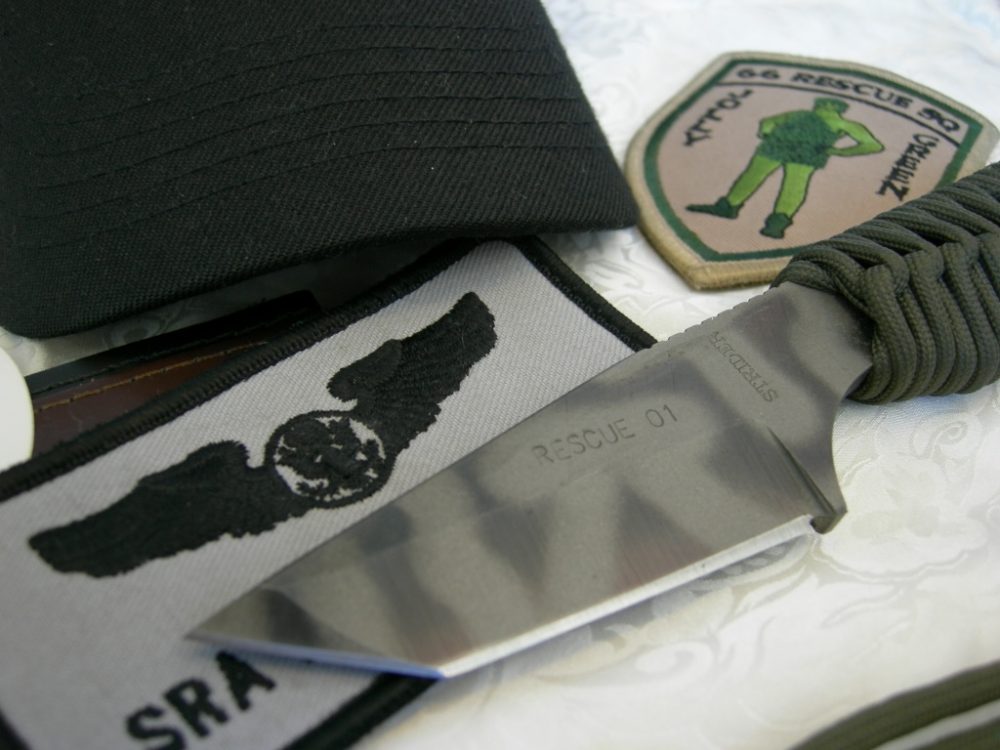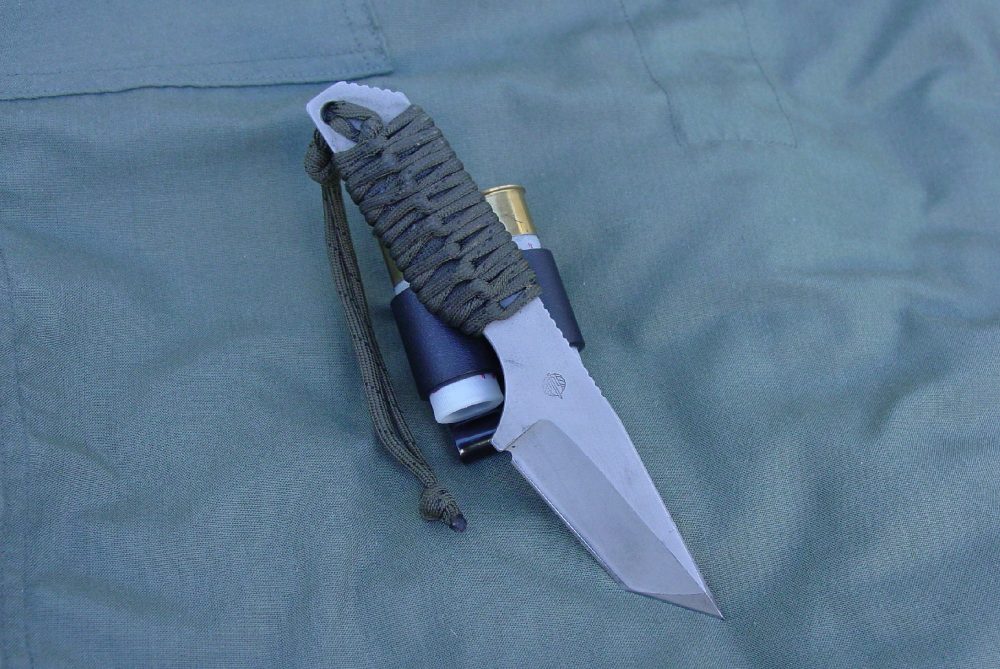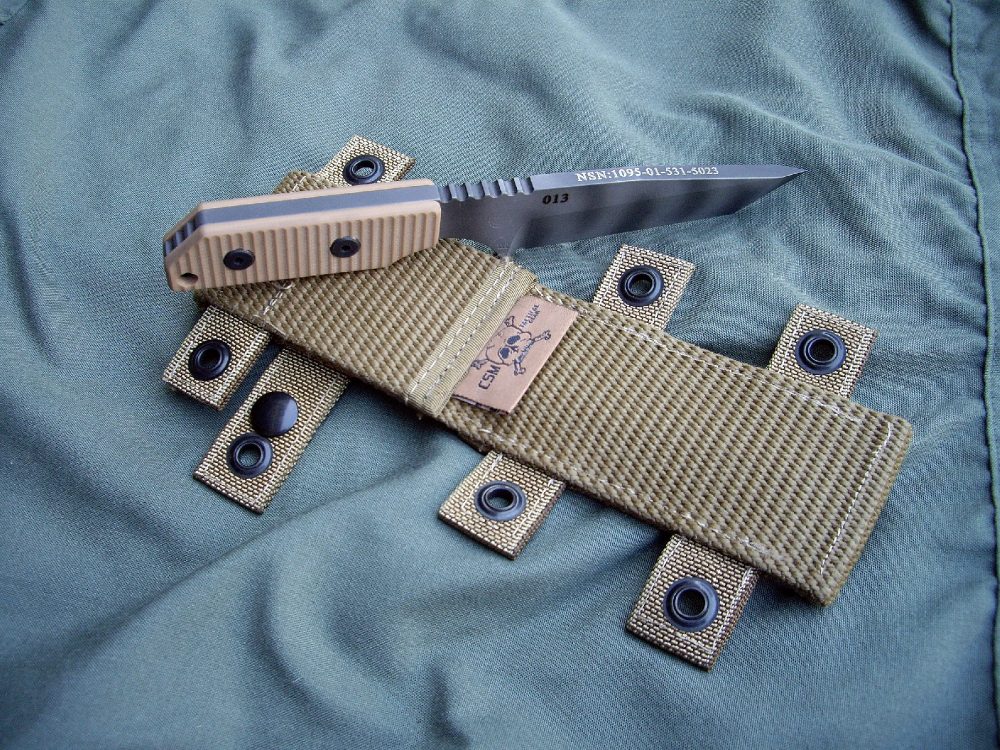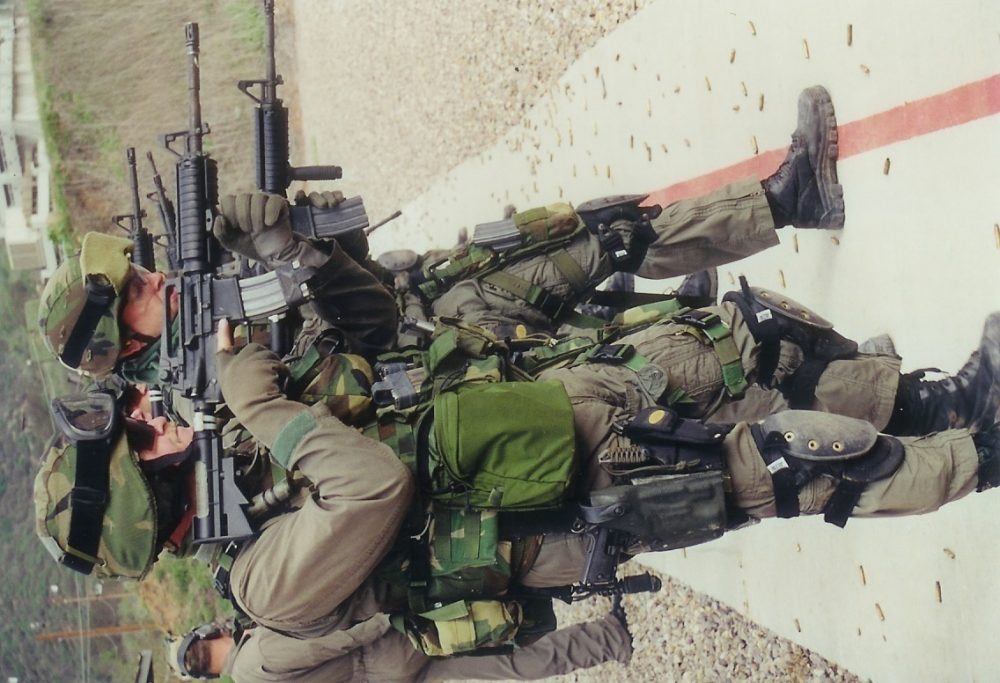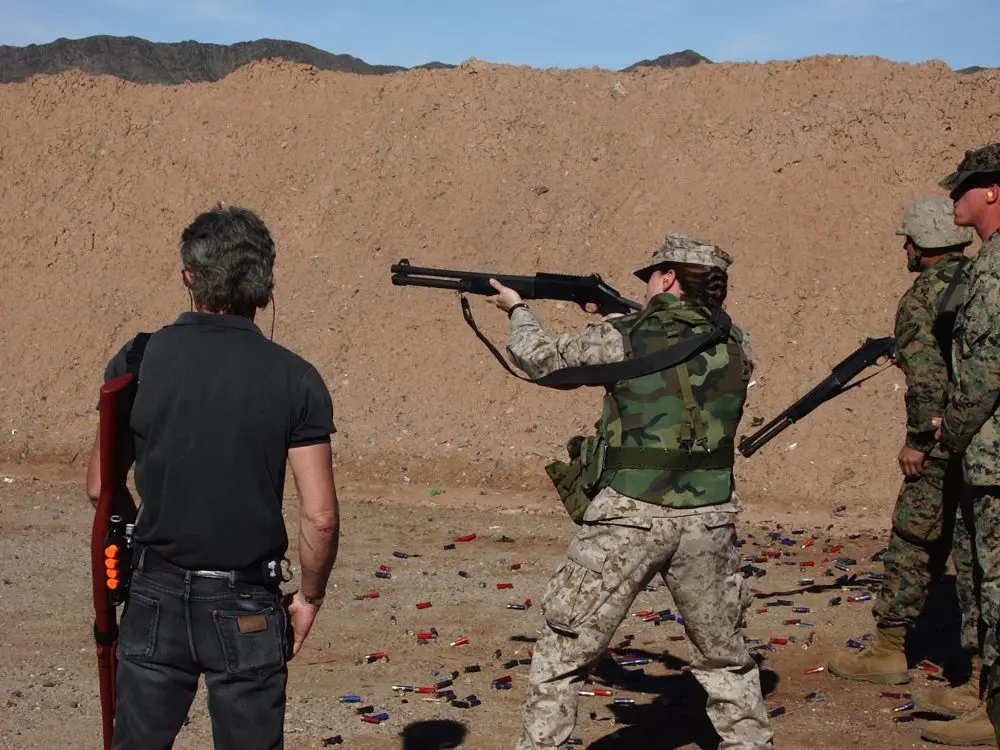From time to time, circumstances arise that result in a solid piece of gear being developed.
In the mid-1990s, a California officer—whose jurisdiction included three interstates, an international airport, major truck stops and a rail line—identified the need for a new tool. This tool needed to be capable of prying and impromptu breaching, yet functional as an edged weapon.
The officer’s search warrant gear had a Strider WB fixed-blade knife on it. The shape was close to what he wanted, but the WB was too big for uniformed carry. The dimensions of the trauma plate pocket were used as a guide for size. Knowing exactly what he wanted, he designed a new tool that would meet the above criteria.
One USAF Air Rescue Squadron purchased several DBs for their enlisted aircrew prior to heading to Afghanistan in late 2001. Note that “RESCUE” is stamped into the blade. Got to love a blade that can fix a jammed mini-gun! Photo courtesy Oliver Wingate.
At this point I need to insert a caveat. The designer is a friend, Darryl Bolke, a retired Ontario, California police officer. Darryl is responsible for an extensive edged weapons program at his former agency and is a very sentient tactical thinker.
Darryl worked with Duane Dwyer, half of the Strider Knives team, on the design of the new knife. Duane’s background includes service as a Marine and a commercial hardhat diver.
Duane previously studied historical daggers and fixed blades. He looked at the work of Fairbairn and Sykes (Shanghai Police), Lt. Col. Sam Yeaton (USMC), Col. Rex Applegate, and blades used by the Marine Raider Battalions and the 1st Special Service Force. Duane credits his views on knives to a Marine Corps officer who said, “A knife is a problem-solving tool.”
Neither Darryl nor Duane wanted a folder. They felt that a folder would give visual and auditory indications when deployed. Duane did not recall seeing a grip cut with a reverse angle before this project. The full-length tang was specifically cut for a reverse angle grip. A benefit is that, when the knife is handled in a point-forward grip, this angle cut rests the tang in the palm. The end result was the Strider DB (Darryl Bolke).
One of the first production DBs, this blade might have one or two stories to tell.
The DB is made of Crucible S30V steel. Duane views S30V (14% chromium and 4% molybdenum) as the best choice for this blade given the environment and user—the war fighter.
A deep choil was added to prevent the hand from running forward onto the blade when thrusting, rather than relying on a hand guard.
The tanto-style blade was chosen for its monstrous tip strength. This tanto tip blade reaches full thickness within the first 3/9-inch. I compared a DB to a spear point Strider I carried overseas. The spear point blade did not reach its full thickness for an inch and a half.
The front end of the blade is not necessarily “dull,” but it won’t be shaving sharp. The forward edge gets driven through objects and needs to be ground at an angle that will not chip during penetration and prying. Most cutting by the Americanized tanto is done where the two angles come together on the bottom of the blade in the front. This little triangle cuts as well as the long edge on the bottom of the blade. Duane has said, “You don’t shave with a splitting maul, and you don’t split logs with a straight razor.” The mission drives the design.
Original prototype is in the center. On the left, top to bottom, are an early production version, the Gunner Grip and a prototype DB-L made for a firearms manufacturer. On the right, a current production model, one of the Ontario PD Air Support Unit models and the DB-L NSN as issued in the USMC Assaulters Kit.
Ontario PD’s chief helicopter pilot and chief mechanic took one of their helicopters on a post-maintenance test flight. At 70 feet above the ground, their engine quit on them. They could not auto-rotate and crashed. They hit hard enough that the seatbelts had tightened up and they could not un-strap themselves. While the helo remained upright, it caught fire. Fortunately, nearby citizens assisted in extracting the crew.
In another incident, a Hughes 500 suffered another hard, unplanned landing. The doors wedged shut, trapping the crew until the doors could be pried open.
Ontario PD tested the problems with the doors on a Hughes 500. With a DB, they were quickly able to force the door out of the frame. Now, the OPD Air Support Unit issues a DB to all aircrew. They also require that they be carried when flying.
One of the nastier stoppages an AR platform can suffer from is the “Type Ate.” Using a stout fixed blade, like the DB, can make clearing this a whole lot easier.
The knife’s usage is not limited to law enforcement aviation. In 2001, a U.S. Air Force air rescue squadron purchased DBs for their deployment to Afghanistan. One was issued to every enlisted air crewman—flight engineer, aerial gunner and para-rescueman. Each blade was stamped with RESCUE and a serial number.
These knives flew throughout Operation Enduring Freedom, including Operation Anaconda. Several of these crews were awarded Silver Stars and Distinguished Flying Crosses as a result of their efforts in the fight. One aerial gunner who carried a DB-RESCUE described it as a “small, compact powerhouse with a wide range of uses” and said the air crewmen carried the DBs religiously.
These blades were used to clear stoppages in various weapons systems such as the mini-guns and heavy machineguns. In the case of the mini-gun, broken bolts blocked the elliptical cam path. A DB was used to pry tool the barrels along their regular firing path, until the broken pieces could be cleared out. The aerial gunner said another flight engineer had broken a different maker’s custom blade trying the same technique on a similar problem.
USMC selected the DB-L for inclusion in their Assaulters Kit. As a result it was assigned a National Stock Number (NSN). Some blades marked with the NSN were sold commercially. The sheath, included, is made by CSM Gear.
One reason for the popularity of the DB in the aviation community is that it is small enough to carry at all times, especially in the confined spaces of a rotary wing aircraft, yet it can still be used to cut oneself out of a “flaming beer can” and then used as an E&E (escape and evasion) tool.
Not every use is as high profile as helo extrication. Lower profile uses are far more frequent. Need to keep a suspect’s partially opened door open? How about sliding the blade in between the door and the frame on the hinge side? Or those locked stash containers that no one ever seems to have the keys to (or so I’ve been told)? With proper application of a DB, the containers open up quickly.
One evening, Darryl handled a welfare check on a female thought to be suicidal. Looking through a window into the second floor apartment, he saw what appeared to be a staged “death scene.” He pried the window frame and popped the lock, entering the apartment. Inside, Darryl found neither a body nor anything further out of the ordinary. He secured the window and departed via the door. Far less damage than booting the door.
In this 1999 photo, Pat Rogers was running a DB on the shroud of his holster (he still does). It was not just for cutting back then, and it isn’t now either. Photo courtesy Patrick A. Rogers.
There are a few variations on the basic DB design. Others include the following:
Some versions made with blade thicknesses of 3/16” and 1/8”. These were too thin to be used like the standard thickness blades and are no longer made.
The GB is a folding variant for those who could not carry a fixed blade on duty due to policy issues.
The EB-DB had a larger, fatter blade with a DB shaped and G10 covered handle.
The DB-4×4 has a 4” handle and a 1” choil with a 4” blade that has almost no angle to its front. Few exist, as they were done for use by an entity needing a mission-specific pry tool.
The DB-L was intended to be openly carried. It is 8 1⁄4” long with a blade length of 4 1/8th”. Originally these were done at the request of an employee at a firearms manufacturing company.
Next is the DB-L NSN. NSN stands for National Stock Number, which this model has. It means the item in question can be ordered through the supply system. This version has the actual stock number stamped on the spine and it is part of the USMC Assaulters Kit.
Finally there is the DB-GG, a standard DB with Gunners Grips scales instead of Para-cord wrap. The grips are made of G10. Very few of these exist. The reason for the G10 scales on the DB-L is interesting. The Marine Corps specifications called for a service life that would exceed that listed as the serviceable life of 550-pound test parachute cord. Organic material could not be used because of rotting or absorbing fluids.
Darryl is now working with Strider on a Law Enforcement specific line. Two projects are in the works. The current plan is that designs will come in tiered versions to meet certain price points.
The DB was intended to be a good, solid general-purpose knife that could easily be concealed. Within those parameters, Darryl designed and Duane executed one heck of a tool. Looking around the user community, I know I am not the only one who thinks this way. Suggested retail is $250.00.
[Having referenced Operation Anaconda, all Americans should be aware of the bravery displayed in that battle. The aerial gunner mentioned in the article recommended the book None Braver for the Air Force perspective of the early war in Afghanistan. Two other books, Not A Good Day To Die and Roberts Ridge, focus on Operation Anaconda.]
SOURCE:
Strider Knives
Dept. S.W.A.T.
120 N. Pacific St. Unit L-7
San Marcos, CA 92069
(760) 471-8275
www.striderknives.com

